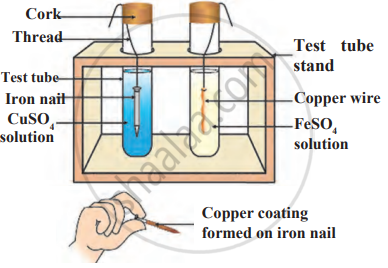Advertisements
Advertisements
प्रश्न
Three metal samples of magnesium, aluminium and iron were taken and rubbed with sandpaper. These samples were then put separately in test tubes containing dilute hydrochloric acid. Thermometers were also suspended in each test tube so that their bulbs dipped in the acid. The rate of formation of bubbles was observed. The above activity was repeated with dilute nitric acid and the observations were recorded.
Answer the following questions:
(i) When the activity was done with dilute hydrochloric acid, then in which one of the test tubes was the rate of formation of bubbles the fastest and the thermometer showed the highest temperature?
(ii) Which metal did not react with dilute hydrochloric acid? Give reason.
(iii) Why is hydrogen gas not evolved when a metal reacts with dilute nitric acid? Name the ultimate products formed in the reaction.
OR
Name the type of reaction on the basis of which the reactivity of metals is decided. You have two metals X and Y. How would you decide which is more reactive than the other?
उत्तर
(i) When the activity was done with dilute hydrochloric acid, the rate of bubble formation was the fastest, and the thermometer showed the highest temperature in the test tube containing magnesium. This indicates that magnesium reacted most vigorously with dilute hydrochloric acid, making the reaction the most exothermic among the metals tested.
(ii) Copper did not react with dilute hydrochloric acid. The absence of bubble formation and no change in temperature indicate that copper does not react with dilute HCl. This is due to copper's relatively low reactivity compared to magnesium, aluminium, and iron.
(iii) Hydrogen gas does not evolve when a metal reacts with dilute nitric acid because nitric acid acts as a strong oxidizing agent. It oxidizes the hydrogen gas produced in the reaction to water and is itself reduced to nitrogen oxides (N2O, NO, NO2). However, exceptions include magnesium (Mg) and manganese (Mn), which can react with very dilute nitric acid to evolve hydrogen gas. The ultimate products formed in reactions with dilute nitric acid are water and nitrogen oxides.
OR
(iii) The type of reaction based on which the reactivity of metals is decided is the displacement reaction. In such reactions, a more reactive metal can displace a less reactive metal from its compound in a solution or molten form. To determine which metal, X or Y, is more reactive, you would introduce metal X into a solution containing a compound of metal Y. If metal X displaces metal Y from its compound, then metal X is more reactive than metal Y. This method provides a simple and straightforward way to compare the reactivity of two metals.
APPEARS IN
संबंधित प्रश्न
Give one example each of which illustrates the following characteristics of a chemical reaction:
evolution of a gas
What do you observe when silver nitrate is added to a solution of sodium chloride?
How will you obtain Zinc chloride from zinc.
Also give balanced equations for the reactions
Write chemical equation for the event.
Electrolysis of alumina is done.
Divide the metals Cu, Zn, Ca, Mg, Fe, Na, Li into three groups, namely reactive metals, moderately reactive metals and less reactive metals.
Select the correct answer for the statement given below:
The catalyst used in the catalytic reaction involving the reactants nitrogen and hydrogen.
Give a balanced equation for the following type of reaction:
A displacement reaction in which a metal above hydrogen in the reactivity series, displaces another metal from the solution of its compound.
In preparation of Aqua regia hydrochloric acid and _______ acid are mixed.
Observe the following diagram and identify the type of reaction and write observation.

Of the three metals X, Y and Z. X reacts with cold water, Y with hot water and Z with steam only. Identify X, Y and Z and also arrange them in order of increasing reactivity.
